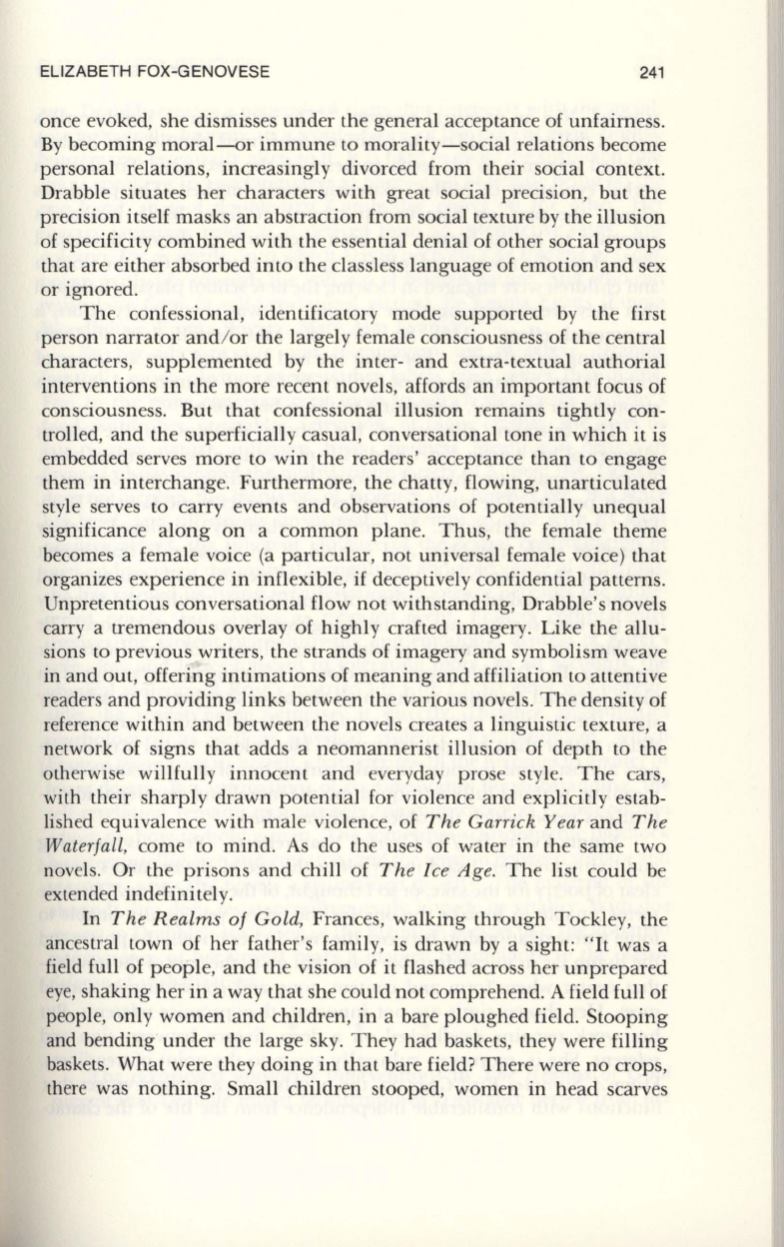
ELIZABETH FOX-GENOVESE
241
once evoked, she dismisses under the general acceptance of unfairness.
By becoming moral-or immune
to
morality-social relations become
personal relations, increasingly divorced from their social context.
Drabble situates her characters with great social precision, but the
precision itself masks an abstraction from social texture by the illusion
of specificity combined with the essential denial of other social groups
that are either absorbed into the classless language of emotion and sex
or ignored.
The confessional, identificatory mode supported by the first
person narrator and/ or the largely female consciousness of the central
characters, supplemented by the inter- and extra-textual authorial
interventions in the more recent novels, affords an important focus of
consciousness. But that confessional illusion remains tightly con–
trolled, and the superficially casual, conversational tone in which it is
embedded serves more to win the readers ' acceptance than
to
engage
them in interchange. Furthermore, the chatty, flowing, unarticulated
style serves
to
carry events and observations of potentially unequal
significance along on a common plane. Thus, the female theme
becomes a female voice (a particular, not universal female voice) that
organizes experience in inflexible, if deceptively confidential patterns.
Unpretentious conversational flow not withstanding, Drabble's novels
carry a tremendous overlay of highly crafted imagery. Like the allu–
sions to previous writers, the strands of imagery and symbolism weave
in and out, offering intimations of meaning and affiliation to attentive
readers and providing links between the various novels. The density of
reference within and between the novels creates a linguistic texture, a
network of signs that adds a neomannerist illusion of depth
to
the
otherwise willfully innocent and everyday prose style. The cars,
with their sharply drawn potential for violence and explicitly estab–
lished equivalence with mal e violence, of
The Garrick Year
and
The
Waterfall,
come to mind. As do the uses of water in the same two
novels. Or the prisons and chill of
The Ice Age.
The list could be
extended indefini tel y.
In
The Realms of Gold,
Frances, walking through Tockley, the
ancestral town of her father's family , is drawn by a sight:
"It
was a
field full of people, and the vision of it flashed across her unprepared
eye, shaking her in a way that she could not comprehend. A field full of
people, only women and children, in a bare ploughed field. Stooping
and bending under the large sky. They had baskets, they were filling
baskets. What were they doing in that bare field? There were no crops,
there was nothing. Small children stooped, women in head scarves


